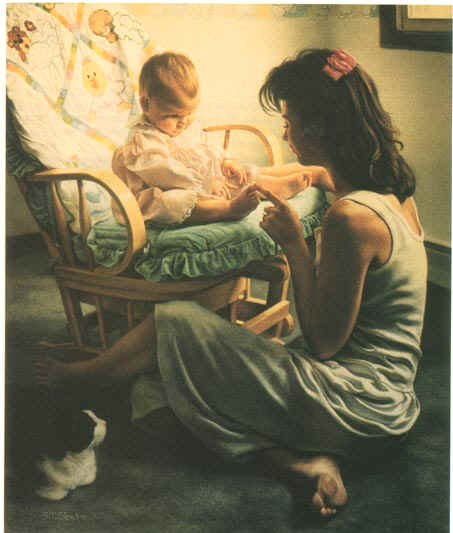|
Lesson
One - The Seeing of Edges

"This Little Piggy" by S.
Thomas Sierak, an American Artist
In looking for a way to "turn
off" the dominant left brain and "turn on" your nondominant
right brain the following is a good exercise. It will force a cognitive
shift and suppress the left brain completely.
Kimon Nicolaides, in his 1941 book, "The
Natural Way to Draw," shows the pure contour method to improve a
student's use of both senses, sight and touch. He asked that they imagine
they were touching the form as they worked. To go a step further on the
tactile thought it was my practice to take an actual object of whatever
the class was drawing. Pass the object around to the students and with
touching it there was a stronger communication to their brain as to its
qualities whether, soft, hard, furry, bumpy, crumbly, etc. For instance,
right around you, the keys on your computer are hard, so is the material
on your mouse, also the desk in front of you is hard.
Paper is hard. A pen is too. However, if
you feel them slowly and carefully you will see there is a distinctly
different registering of the surface of the objects going to your brain
for you to consider.
Once these objects are recorded as tactile
one's brain also registers this and we begin to get into the right brain.
The left brain cannot or will not work at it, and becomes suppressed.
Without further explanation here is the exercise:
Set up the best conditions for making a switch
from left to right brain:
1. Total silence, talking by the students
or the teacher locks students into left mode.
2. Music
3. Better yet, a visual pattern movement
such as dance with good music
4. Find a place you can be totally
uninterrupted for twenty minutes, set an alarm if possible. If you don't
care about keeping track of time (a Left mode function) omit the alarm.
5. Tape down a piece of paper to the table
(absolutely necessary).
6. You are now going to draw your hand
without seeing what you are doing.
7. Turn your body completely away from the
paper so you cannot see the hand drawing.
8. Do not peek at your drawing. The minute
you do you will slip out of the right brain. The impulse will be great but
you must resist looking no matter how overwhelming it is.
9. Focus all your attention on observing
the hand you are drawing as you draw.
10. Focus your eyes to some part of your
hand, observing ever variation and undulation of the edge. As your eyes
move, move your pencil at the same slow pace on the paper, creeping a
Millimeter at a time.
11. Match the movement of the pencil
exactly with your eye. One or the other may attempt to speed up, don't let
it happen.
12. The left brain will say, "Stop
this stupid stuff right now! We don't need to look at things this closely.
I've already named everything, this is boring - if you don't stop, I'll
give you a headache." Ignore this complaining, simply persist. You do
not care if the drawing looks like a hand. After you are finished remember
how you felt. Did you become enthralled with what you saw? Next when you
go again to this state will you recognize it. |

